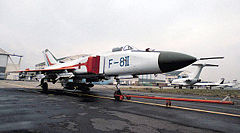Indonesian Space Force Command
Komando Untuk Keamanan Luar Angkasa
Dari Angkatan Antariksa Indonesia
"Kami Menjelajahi Alam Raya untuk Menemukan Keagungan Sang Maha Kuasa"
~Gen. Arip Nurahman~
(Komando Pasukan Khusus Angkatan Antariksa Indonesia)
(Korps Pasukan Khas Angkatan Udara)
Jet-powered fighters
It has become common in the aviation community to classify jet fighters by "generations" for historical purposes. There
are no official definitions of these generations; rather, they
represent the notion that there are stages in the development of fighter
design approaches, performance capabilities, and technological
evolution.
The
timeframes associated with each generation are inexact and are only
indicative of the period during which their design philosophies and
technology employment enjoyed a prevailing influence on fighter design
and development. These timeframes also encompass the peak period of
service entry for such aircraft.
Third-generation jet fighters (early 1960s to circa 1970)
The
third generation witnessed continued maturation of second-generation
innovations, but it is most marked by renewed emphases on
maneuverability and traditional ground-attack capabilities. Over the
course of the 1960s, increasing combat experience with guided missiles
demonstrated that combat would devolve into close-in dogfights. Analog avionics
began to be introduced, replacing older "steam-gauge" cockpit
instrumentation. Enhancements to improve the aerodynamic performance of
third-generation fighters included flight control surfaces such as canards, powered slats, and blown flaps. A number of technologies would be tried for Vertical/Short Takeoff and Landing, but thrust vectoring would be successful on the Harrier jump jet.
Growth
in air combat capability focused on the introduction of improved
air-to-air missiles, radar systems, and other avionics. While guns
remained standard equipment (early models of F-4 being a notable
exception), air-to-air missiles became the primary weapons for air
superiority fighters, which employed more sophisticated radars and
medium-range RF AAMs to achieve greater "stand-off" ranges, however,
kill probabilities proved unexpectedly low for RF missiles due to poor
reliability and improved electronic countermeasures (ECM) for spoofing radar seekers.
Infrared-homing AAMs saw their fields of view expand to 45°, which strengthened their tactical usability. Nevertheless, the low dogfight loss-exchange ratios experienced by American fighters in the skies over Vietnam led the U.S. Navy to establish its famous "TOPGUN" fighter weapons school, which provided a graduate-level curriculum to train fleet fighter pilots in advanced Air Combat Maneuvering (ACM) and Dissimilar Air Combat Training (DACT) tactics and techniques.
Infrared-homing AAMs saw their fields of view expand to 45°, which strengthened their tactical usability. Nevertheless, the low dogfight loss-exchange ratios experienced by American fighters in the skies over Vietnam led the U.S. Navy to establish its famous "TOPGUN" fighter weapons school, which provided a graduate-level curriculum to train fleet fighter pilots in advanced Air Combat Maneuvering (ACM) and Dissimilar Air Combat Training (DACT) tactics and techniques.
This
era also saw an expansion in ground-attack capabilities, principally
in guided missiles, and witnessed the introduction of the first truly
effective avionics for enhanced ground attack, including terrain-avoidance systems. Air-to-surface missiles (ASM) equipped with electro-optical (E-O) contrast seekers – such as the initial model of the widely used AGM-65 Maverick – became standard weapons, and laser-guided bombs (LGBs) became widespread in effort to improve precision-attack capabilities. Guidance for such precision-guided munitions (PGM) was provided by externally mounted targeting pods, which were introduced in the mid-1960s.
It also led to the development of new automatic-fire weapons, primarily chain-guns that use an electric engine to drive the mechanism of a cannon; this allowed a single multi-barrel weapon (such as the 20 mm Vulcan)
to be carried and provided greater rates of fire and accuracy.
Powerplant reliability increased and jet engines became "smokeless" to
make it harder to visually sight aircraft at long distances.
Dedicated ground-attack aircraft (like the Grumman A-6 Intruder, SEPECAT Jaguar and LTV A-7 Corsair II) offered longer range, more sophisticated night attack systems or lower cost than supersonic fighters. With variable-geometry wings, the supersonic F-111 introduced the Pratt & Whitney TF30, the first turbofan
equipped with afterburner. The ambitious project sought to create a
versatile common fighter for many roles and services. It would serve
well as an all-weather bomber, but lacked the performance to defeat
other fighters. The McDonnell F-4 Phantom was designed around radar and
missiles as an all-weather interceptor, but emerged as a versatile strike bomber nimble enough to prevail in air combat, adopted by the U.S. Navy, Air Force and Marine Corps.
Despite numerous shortcomings that would be not be fully addressed until newer fighters, the Phantom claimed 280 aerial kills, more than any other U.S. fighter over Vietnam.[6] With range and payload capabilities that rivaled that of World War II bombers such as B-24 Liberator, the Phantom would became a highly successful multirole aircraft.
Despite numerous shortcomings that would be not be fully addressed until newer fighters, the Phantom claimed 280 aerial kills, more than any other U.S. fighter over Vietnam.[6] With range and payload capabilities that rivaled that of World War II bombers such as B-24 Liberator, the Phantom would became a highly successful multirole aircraft.
- See also: List of third generation jet fighters
Powered By:
Tentara Nasional Indonesia Angkatan Darat (Indonesian Army)
Tentara Nasional Indonesia Angkatan Laut (Indonesian Navy)
Tentara Nasional Indonesia Angkatan Udara (Indonesian Air Force)
Sumber: Wikipedia




































